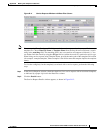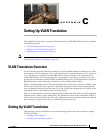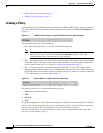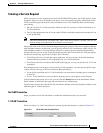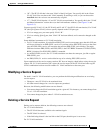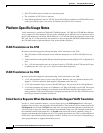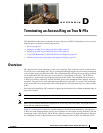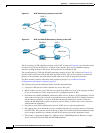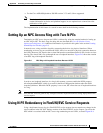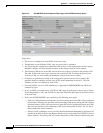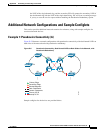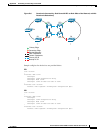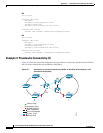
D-1
Cisco IP Solution Center L2VPN and Carrier Ethernet User Guide, 6.0
OL-21636-01
APPENDIX
D
Terminating an Access Ring on Two N-PEs
This appendix describes how to terminate an access ring on two N-PEs for redundancy in case an access
link goes down. It contains the following sections:
• Overview, page D-1
• Setting Up an NPC Access Ring with Two N-PEs, page D-3
• Setting Up an NPC Access Ring with Two N-PEs, page D-3
• Using N-PE Redundancy in FlexUNI/EVC Service Requests, page D-3
• Additional Network Configurations and Sample Configlets, page D-5
Overview
ISC supports device-level redundancy in the service topology. This allows the service to remain active
in case one access link should drop. This is accomplished through support for provisioning termination
of access links against two different N-PEs. This is implemented by allowing an access ring to terminate
on two different N-PEs. This may also be described as a “dual-homed access ring.” The N-PEs are
connected by a logical link using loopback interfaces on the N-PEs. The redundant link starts from a
U-PE device and may, optionally, include PE-AGG devices. One attachment link is primary and one is
secondary. The selection is made when the Named Physical Circuit (NPC) is created. The terminating
device on the NPC acts as the primary N-PE, while the other N-PE on the same ring acts as the secondary
N-PE.
For backward compatibility, ISC continues to support provisioning services without redundant links, as
in previous releases.
Note N-PE redundancy is only supported for FlexUNI/EVC services.
Note MPLS service requests should not be deployed on access rings with two N-PEs. This might result in
errors with the generated configlets.
Figure D-1 and Figure D-2 show two network topologies which illustrate redundancy, starting from a
U-PE access node. Both topologies provide open segments for each uplink, starting from the U-PE and
terminating on the N-PE devices. The N-PEs are logically connected via loopback interfaces. Services
are configured on both of these Ethernet access links starting from the U-PE to two different N-PEs.



